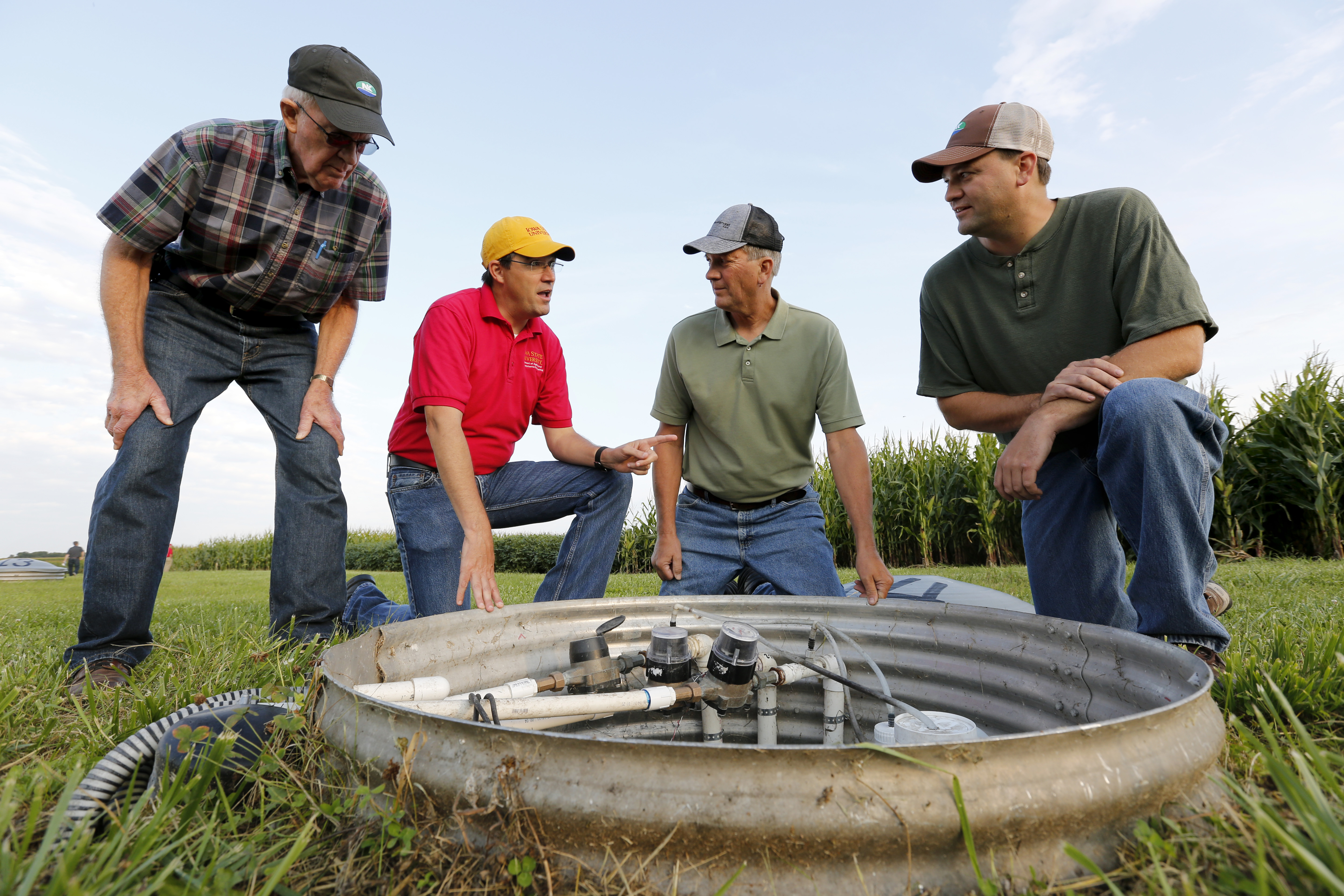
Generations of Research, Recommendations, Results
Six generations of Bob Lynch’s family have farmed near the edge of Gilmore City in the center of Iowa’s prairie pothole region. When the Pocahontas Soil and Water Conservation District purchased land nearby in 1990 to work with Iowa State University to conduct water quality research, area farmers were invited to participate. The Lynch family welcomed the opportunity.
Initial research at the Gilmore City site and on neighboring farms was aimed at determining if pesticides and fertilizers from farm fields were entering potential drinking water sources through agricultural drainage wells. Research results showed pesticides were not contaminating ground waters, but the amount of nitrate entering the wells frequently exceeded the EPA drinking water standard. The findings and recommendations led to the establishment of cost-share programs to assist farmers in closing the wells and constructing alternative drainage systems.
The agricultural drainage well on Bob Lynch’s (’77 farm operations) family farmland has since been closed, and over the years they implemented more and more conservation practices, as they learned bout them. The practices include no-till soybeans, strip-till corn and cover crops, which have increased organic matter on their fields, reduced the amount of nitrogen they use and reduced ponding.
“With cover crops in the no-till system, a lot of times that first two to three inches of rain just soaks right in because of all the holes we have from the earthworms, microorganisms and roots. It doesn’t pond a lot. When we have more rain than that, or it persists over time, then it ponds. We are in the prairie pothole region up here, so that’s going to happen,” says Lynch.
Local research, local impacts
Carl Pederson, an agricultural specialist with Iowa State University Extension and Outreach who has conducted research at the site, says long-term research sites reduce farmer risks associated with experimenting with new practices and products.
“Farmers like to see how we do it first and how it worked out. For example, maybe area farmers are reluctant to try cover crops. They want to see how it looks on our field plots first, over multiple seasons. They’re always welcome to come over and see how those practices are working,” says Pederson (’90 agricultural mechanization).
This August, Lynch, along with his father, Larry (’55 farm operations), son, Jay, and 90 farmers and agricultural specialists from Iowa State and other organizations, attended a field day at the drainage research and demonstration site at Gilmore City. Iowa Secretary of Agriculture, Bill Northey, and others spoke, marking the 25th anniversary of the site.
“At Iowa State University, for greater than two decades, we’ve been very fortunate to have a state-of-the-art subsurface drainage research facility, where we’re able to measure all the water that’s flowing from tile drains and collect flow-weighted water samples for research,” says Matt Helmers, professor of agricultural and biosystems engineering at Iowa State.
The site was established primarily in response to Iowa’s 1987 Groundwater Protection Act and focused on agricultural drainage well research. Since that time the focus has shifted to understanding nutrient loss with subsurface drainage.
Research at the Gilmore City site has produced answers to questions about plant nitrogen needs, application rates, timing, application methods and forms of nitrogen and additives. In the last 12 years, they have also examined the impact of a winter, cereal rye cover crop on nitrate concentration and loss in tile lines. Findings include the fact that a cereal rye cover crop can reduce nitrate loss to tile lines by greater than 20 percent.
Other sites throughout the state have shown greater reductions in nitrate loss due to the integration of cereal rye demonstrating that performance can vary. Future work at the Gilmore City site will study how to maximize the benefits of cover crops in this area of the state.
Understanding the N factor
Helmers says the Gilmore City site was key to obtaining relevant, Iowa-based data for a 2012 science assessment, which was used to develop Iowa’s Nutrient Reduction Strategy. Helmers and others have been able to use the assessment to recommend best management practices for meeting Iowa’s water quality goals.
Perhaps the most important recent finding, confirmed by long-term collection of research data at the site, is that nitrate loss to tile lines in Iowa farmland is primarily due to the absence of nitrate uptake by live plant roots in the fall and spring of the year. Iowa soils are naturally rich in nitrogen. Nitrate not taken up by plants, whether naturally present in the soil or added for crop growth, moves with water.
“That’s a really important finding. It illustrates that this is more about land use and the hydrology of the system than about mismanagement of nutrient resources that we’re putting on crops,” says Helmers.
James L. Baker, a former Iowa State professor of agricultural and biosystems engineering, who conducted research at the site from the time of its construction in 1987 up to his retirement in 2004, says long-term experiments are needed to compensate for year-to-year weather variability.
“Also, water quality and soil quality impacts from what you do at the soil surface may not show up for several years. So the extreme advantage we have had at this site is the stable funding through the Iowa Department of Agriculture and Land Stewardship. I think the project over the years has brought a better understanding of the corn-soybean production system and provided good results that producers can believe in,” says Baker.
“We have five of these types of sites across the state. Many states don’t have any research facilities like this and for us to have five facilities is unique and is allowing Iowa to be a leader in looking at how in-field management practices impact water quality,” says Helmers.



